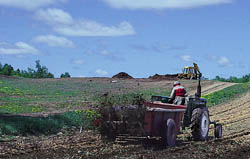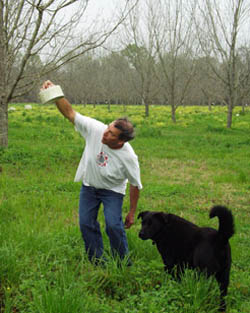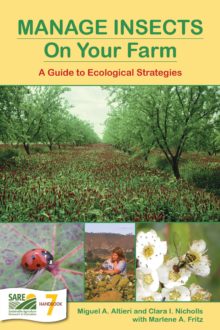
Enhancing Biota and Improving Soil Health
Managing soil for improved health demands a long-term commitment to using combinations of soil-enhancing practices. The strategies listed below can aid you in inhibiting pests, stimulating natural enemies and—by alleviating plant stress—fortifying crops’ abilities to resist or compete with pests.
Add plentiful amounts of organic materials from cover crops and other crop residues as well as from off-field sources like animal manures and composts. Because different organic materials have different effects on a soil’s biological, physical and chemical properties, be sure to use a variety of sources. For example, well-decomposed compost may suppress crop diseases, but it does not enhance soil aggregation in the short run. Dairy cow manure, on the other hand, rapidly stimulates soil aggregation.

- Keep soils covered with living vegetation and/or crop residue. Residue protects soils from moisture and temperature extremes. For example, residue allows earthworms to adjust gradually to decreasing temperatures, reducing their mortality. By enhancing rainfall infiltration, residue also provides more water for crops.
- Reduce tillage intensity. Excessive tillage destroys the food sources and microniches on which beneficial soil organisms depend. When you reduce your tillage and leave more residues on the soil surface, you create a more stable environment, slow the turnover of nutrients and encourage more diverse communities of decomposers.
- Adopt other practices that reduce erosion, such as strip cropping along contours. Erosion damages soil health by removing topsoil that is rich in organic matter.
- Alleviate the severity of compaction. Staying off soils that are too wet, distributing loads more uniformly and using controlled traffic lanes—including raised beds—all help reduce compaction.
- Use best management practices to supply nutrients to plants without polluting water. Make routine use of soil and plant tissue tests to determine the need for nutrient applications. Avoid applying large doses of available nutrients, especially nitrogen, before planting. To the greatest extent possible, rely on soil organic matter and organic amendments to supply nitrogen. If you must use synthetic nitrogen fertilizer, add it in smaller quantities several times during the season. Once soil tests are in the optimal range, try to balance the amount of nutrients supplied with the amount used by the crops.
- Leave areas of the farm untouched as habitat for plant and animal diversity.
Individual soil-improving practices have multiple effects on the agro-ecosystem. When you use cover crops intensively, you supply nitrogen to the following crop, soak up leftover soil nitrates, increase soil organisms and improve crop health. You reduce runoff, erosion, soil compaction and plant-parasitic nematodes. You also suppress weeds, deter diseases and inoculate future crops with beneficial mycorrhizae. Flowering cover crops also harbor beneficial insects.
CAUTION: When designing fields to manage specific pests, other pests can reach damaging levels. For example, spacing crops closely can prompt disease outbreaks.
